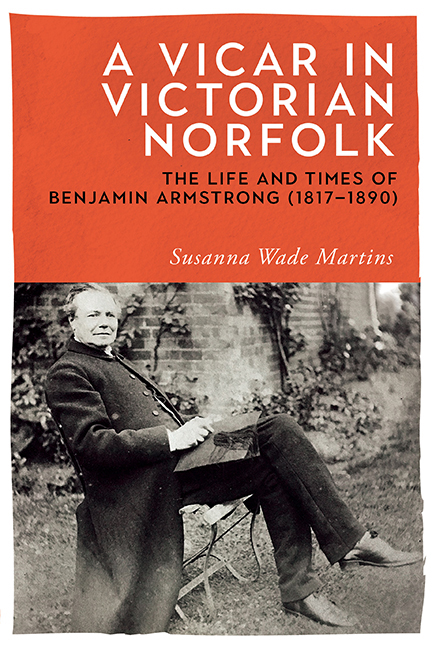Book contents
- Frontmatter
- Contents
- List of Illustrations
- Acknowledgements
- Foreword
- Author's Note
- Map
- Introduction
- I The Early Years
- 1 Early Life
- 2 The Move to Dereham
- II Public Life
- 3 The Norfolk Clergy
- 4 Church Life
- 5 The Building Legacy
- 6 Schools
- 7 Town Life
- III Family and Friends
- 8 Family Life
- 9 Friends
- IV Later Life
- 10 The Later Years
- 11 Armstrong: A Man of His Time
- Bibliography
- Timeline
- Index
Introduction
Published online by Cambridge University Press: 14 August 2020
- Frontmatter
- Contents
- List of Illustrations
- Acknowledgements
- Foreword
- Author's Note
- Map
- Introduction
- I The Early Years
- 1 Early Life
- 2 The Move to Dereham
- II Public Life
- 3 The Norfolk Clergy
- 4 Church Life
- 5 The Building Legacy
- 6 Schools
- 7 Town Life
- III Family and Friends
- 8 Family Life
- 9 Friends
- IV Later Life
- 10 The Later Years
- 11 Armstrong: A Man of His Time
- Bibliography
- Timeline
- Index
Summary
When the Revd Benjamin Armstrong sat at his desk in his study in the fenland parish of Crowle to summarise his early journals before beginning one which he would write nearly every day from 1842 to 1887, he was part of a tradition of clergy diarists. These diaries are now seen as an important corrective to the previous tendency to write the history of the church from the top down, concentrating on the theologians in Oxford and Cambridge, the Ecclesiastical Commissions and the reforming bishops both in the House of Lords and their dioceses. The parson, along with the squire, if he were resident, was likely to be the most educated and influential person in his rural parish. It was the clergyman who would be the face of the established church to his parishioners and on him rested the responsibility for the ensuring the influence of the church and implementing reforms at grass-roots level. This was especially true of the Victorian Anglican church, with its supporters of high and low church practices and the conflicts between science and literal interpretations of the Bible. The famous and influential players have dominated the pages of the standard histories. While ‘thought of prelates, politicians and dons provides a valuable insight into the minds of those shaping opinion, it avoids the question of how (or even if) their ideas were assimilated in the country at large’. What Armstrong’s diaries have allowed us to do is to see how these major controversies were played out at parish level; they add a further dimension to the increasing, but still limited, number of studies in which the clergy and their parishioners are placed centre-stage.
The earliest histories of the Victorian church were written from the high church standpoint, filtering events through the eyes of a few Oxford men. As early as 1891 the Anglo-Catholic R.W. Church published The Oxford Movement: Twelve Years, 1833–1841, in which the supporters of the high church are credited with saving the church from decline. The Evangelicals also offered their distinctive interpretation, the most influential being G.R. Ballentine's A History of the Evangelical Party in the Church of England (1908). While Owen Chadwick's authoritative two-volume The Victorian Church (1966 and 1970) devotes a chapter to the ‘Country Parson’, scholars have continued to concentrate on conflicts within the church, the role of church leaders and government reforms.
- Type
- Chapter
- Information
- A Vicar in Victorian NorfolkThe Life and Times of Benjamin Armstrong (1817–1890), pp. 1 - 12Publisher: Boydell & BrewerPrint publication year: 2018

